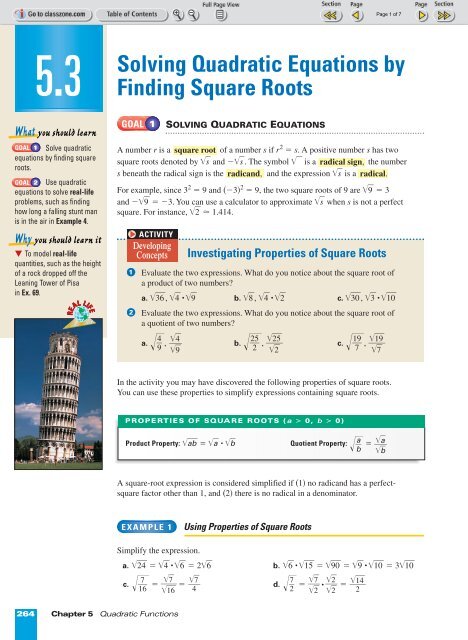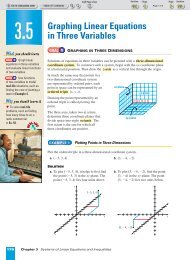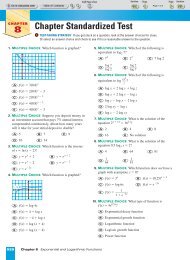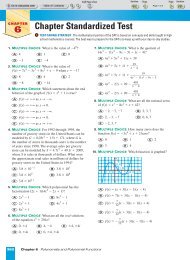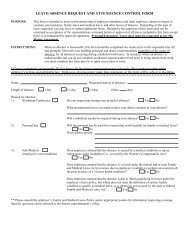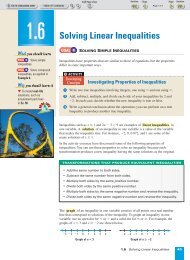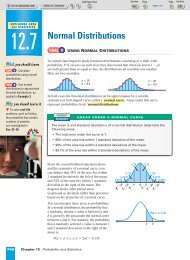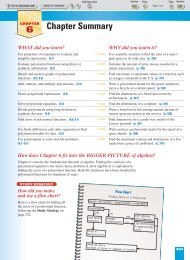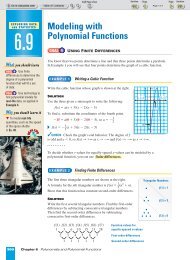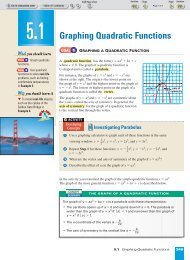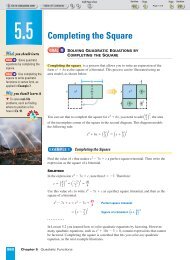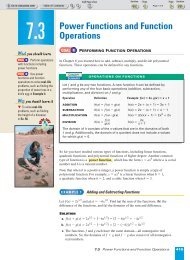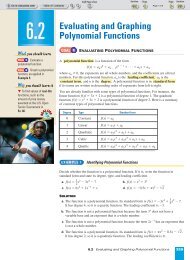Square Roots - Beau Chene High School Home Page
Square Roots - Beau Chene High School Home Page
Square Roots - Beau Chene High School Home Page
Create successful ePaper yourself
Turn your PDF publications into a flip-book with our unique Google optimized e-Paper software.
5.3<br />
Solving Quadratic Equations by<br />
Finding <strong>Square</strong> <strong>Roots</strong><br />
What you should learn<br />
GOAL 1 Solve quadratic<br />
equations by finding square<br />
roots.<br />
GOAL 2 Use quadratic<br />
equations to solve real-life<br />
problems, such as finding<br />
how long a falling stunt man<br />
is in the air in Example 4.<br />
Why you should learn it<br />
To model real-life<br />
quantities, such as the height<br />
of a rock dropped off the<br />
Leaning Tower of Pisa<br />
in Ex. 69.<br />
REAL<br />
LIFE<br />
GOAL 1<br />
SOLVING QUADRATIC EQUATIONS<br />
A number r is a square root of a number s if r 2 = s. A positive number s has two<br />
square roots denoted by s and ºs. The symbol is a radical sign, the number<br />
s beneath the radical sign is the radicand, and the expression s is a radical.<br />
For example, since 3 2 = 9 and (º3) 2 = 9, the two square roots of 9 are 9 = 3<br />
and º9 = º3. You can use a calculator to approximate s when s is not a perfect<br />
square. For instance, 2 ≈ 1.414.<br />
1<br />
2<br />
ACTIVITY<br />
Developing<br />
Concepts<br />
Investigating Properties of <strong>Square</strong> <strong>Roots</strong><br />
Evaluate the two expressions. What do you notice about the square root of<br />
a product of two numbers?<br />
a. 36, 4 • 9 b. 8, 4 • 2 c. 30, 3 • 10<br />
Evaluate the two expressions. What do you notice about the square root of<br />
a quotient of two numbers?<br />
a. , 4 9 4<br />
b. 25 <br />
2 <br />
25<br />
, c. 19 <br />
7 , 19<br />
9<br />
2<br />
7<br />
In the activity you may have discovered the following properties of square roots.<br />
You can use these properties to simplify expressions containing square roots.<br />
PROPERTIES OF SQUARE ROOTS (a > 0, b > 0)<br />
Product Property: ab = a • b<br />
Quotient Property:<br />
a<br />
<br />
b<br />
= a b<br />
A square-root expression is considered simplified if (1) no radicand has a perfectsquare<br />
factor other than 1, and (2) there is no radical in a denominator.<br />
EXAMPLE 1<br />
Using Properties of <strong>Square</strong> <strong>Roots</strong><br />
Simplify the expression.<br />
a. 24 = 4 • 6 = 26 b. 6 • 15 = 90 = 9 • 10 = 310<br />
c. 1 7<br />
6 7 7<br />
= = d. 7 2 7 2<br />
= • = 14<br />
<br />
16<br />
4<br />
<br />
2<br />
<br />
2<br />
2<br />
264 Chapter 5 Quadratic Functions
7<br />
In part (d) of Example 1, the square root in the denominator of was<br />
2<br />
eliminated by multiplying both the numerator and the denominator by 2.<br />
This process is called rationalizing the denominator.<br />
You can use square roots to solve some types of quadratic equations. For instance,<br />
if s > 0, then the quadratic equation x 2 = s has two real-number solutions: x = s<br />
and x = ºs. These solutions are often written in condensed form as x = ±s.<br />
The symbol ±s is read as “plus or minus the square root of s.”<br />
EXAMPLE 2<br />
Solving a Quadratic Equation<br />
Solve 2x 2 + 1 = 17.<br />
SOLUTION<br />
Begin by writing the equation in the form x 2 = s.<br />
2x 2 + 1 = 17<br />
Write original equation.<br />
2x 2 = 16<br />
Subtract 1 from each side.<br />
x 2 = 8 Divide each side by 2.<br />
x = ±8<br />
x = ±22<br />
Take square roots of each side.<br />
Simplify.<br />
The solutions are 22 and º22.<br />
✓CHECK You can check the solutions algebraically<br />
by substituting them into the original equation. Since<br />
this equation is equivalent to 2x 2 º 16 = 0, you can<br />
also check the solutions by graphing y = 2x 2 º16<br />
and observing that the graph’s x-intercepts appear to<br />
be about 2.8 ≈ 22 and º2.8 ≈ º22.<br />
EXAMPLE 3<br />
Solving a Quadratic Equation<br />
STUDENT HELP<br />
HOMEWORK HELP<br />
Visit our Web site<br />
www.mcdougallittell.com<br />
for extra examples.<br />
INTERNET<br />
Solve 1 3 (x +5)2 = 7.<br />
SOLUTION<br />
1 3 (x +5)2 = 7<br />
Write original equation.<br />
(x +5) 2 = 21 Multiply each side by 3.<br />
x + 5 = ±21<br />
Take square roots of each side.<br />
x = º5 ± 21 Subtract 5 from each side.<br />
The solutions are º5 + 21 and º5 º 21.<br />
✓CHECK Check the solutions either by substituting them into the original equation<br />
or by graphing y = 1 3 (x +5)2 º 7 and observing the x-intercepts.<br />
5.3 Solving Quadratic Equations by Finding <strong>Square</strong> <strong>Roots</strong> 265
GOAL 2<br />
USING QUADRATIC MODELS IN REAL LIFE<br />
When an object is dropped, its speed continually increases, and therefore its height<br />
above the ground decreases at a faster and faster rate. The height h (in feet) of the<br />
object t seconds after it is dropped can be modeled by the function<br />
h = º16t 2 + h 0<br />
where h 0 is the object’s initial height. This model assumes that the force of air<br />
resistance on the object is negligible. Also, the model works only on Earth. For<br />
planets with stronger or weaker gravity, different models are used (see Exercise 71).<br />
REAL<br />
LIFE<br />
EXAMPLE 4<br />
Modeling a Falling Object’s Height with a Quadratic Function<br />
Movies<br />
A stunt man working on the set of a movie is to fall out of a window 100 feet above<br />
the ground. For the stunt man’s safety, an air cushion 26 feet wide by 30 feet long by<br />
9 feet high is positioned on the ground below the window.<br />
a. For how many seconds will the stunt man fall before he reaches the cushion?<br />
b. A movie camera operating at a speed of 24 frames per second records the stunt<br />
man’s fall. How many frames of film show the stunt man falling?<br />
SOLUTION<br />
a. The stunt man’s initial height is h 0 = 100 feet, so his height as a function of time<br />
is given by h = º16t 2 + 100. Since the top of the cushion is 9 feet above the<br />
ground, you can determine how long it takes the stunt man to reach the cushion<br />
by finding the value of t for which h = 9 . Here are two methods:<br />
Method 1: Make a table of values.<br />
t 0 1 2 3<br />
h 100 84 36 º44<br />
From the table you can see that h = 9 at a value of t between t = 2 and t = 3.<br />
It takes between 2 sec and 3 sec for the stunt man to reach the cushion.<br />
Method 2: Solve a quadratic equation.<br />
h = º16t 2 + 100 Write height function.<br />
9 = º16t 2 + 100 Substitute 9 for h.<br />
º91 = º16t 2 Subtract 100 from each side.<br />
91<br />
<br />
16 = t2 Divide each side by –16.<br />
9 1 1 6 = t<br />
Take positive square root.<br />
2.4 ≈ t Use a calculator.<br />
It takes about 2.4 seconds for the stunt man to reach the cushion.<br />
b. The number of frames of film that show the stunt man falling is given by the<br />
product (2.4 sec)(24 frames/sec), or about 57 frames.<br />
266 Chapter 5 Quadratic Functions
GUIDED PRACTICE<br />
Vocabulary Check ✓<br />
Concept Check ✓<br />
Skill Check ✓<br />
1. Explain what it means to “rationalize the denominator” of a quotient containing<br />
square roots.<br />
2. State the product and quotient properties of square roots in words.<br />
3. How many real-number solutions does the equation x 2 = s have when s >0?<br />
when s = 0? when s
SOLVING QUADRATIC EQUATIONS Solve the equation.<br />
60. 2(x º3) 2 = 8 61. 4(x +1) 2 = 100 62. º3(x +2) 2 = º18<br />
63. 5(x º7) 2 = 135 64. 8(x +4) 2 = 9 65. 2(a º6) 2 º 45 = 53<br />
66. 1 4 (b º8)2 = 7 67. (2r º5) 2 = 81 68. (s + 1) 2<br />
º 1 2<br />
= 1 5<br />
<br />
10 5 2<br />
ASTRONOMY The<br />
acceleration due to<br />
gravity on the moon is about<br />
5.3 ft/sec 2 . This means that<br />
the moon’s gravity is only<br />
about one sixth as strong as<br />
Earth’s.<br />
APPLICATION LINK<br />
www.mcdougallittell.com<br />
REAL<br />
INTERNET<br />
FOCUS ON<br />
APPLICATIONS<br />
LIFE<br />
69. HISTORY CONNECTION According to legend, in 1589 the Italian scientist Galileo<br />
Galilei dropped two rocks of different weights from the top of the Leaning Tower<br />
of Pisa. He wanted to show that the rocks would hit the ground at the same time.<br />
Given that the tower’s height is about 177 feet, how long would it have taken for<br />
the rocks to hit the ground?<br />
70. ORNITHOLOGY Many birds drop shellfish onto<br />
rocks to break the shell and get to the food inside.<br />
Crows along the west coast of Canada use this technique<br />
to eat whelks (a type of sea snail). Suppose a crow drops<br />
a whelk from a height of 20 feet, as shown.<br />
Source: Cambridge Encyclopedia of Ornithology<br />
a. Write an equation giving the whelk’s height h<br />
(in feet) after t seconds.<br />
b. Use the Table feature of a graphing calculator to find<br />
h when t = 0, 0.1, 0.2, 0.3, . . . , 1.4, 1.5. (You’ll need<br />
to scroll down the table to see all the values.) To the<br />
nearest tenth of a second, how long does it take for<br />
the whelk to hit the ground? Check your answer by<br />
solving a quadratic equation.<br />
71. ASTRONOMY On any planet, the height h (in feet) of a falling object<br />
t seconds after it is dropped can be modeled by<br />
h = º g 2 t2 + h 0<br />
20 ft<br />
where h 0 is the object’s initial height and g is the acceleration (in feet per second<br />
squared) due to the planet’s gravity. For each planet in the table, find the time it<br />
takes for a rock dropped from a height of 200 feet to hit the ground.<br />
Planet Earth Mars Jupiter Neptune Pluto<br />
g (ft/sec 2 ) 32 12 81 36 2.1<br />
Source: STARLab, Stanford University<br />
STUDENT HELP<br />
Skills Review<br />
For help with the<br />
Pythagorean theorem,<br />
see p. 917.<br />
72. OCEANOGRAPHY The equation h = 0.019s 2 gives the height h (in feet) of<br />
the largest ocean waves when the wind speed is s knots. How fast is the wind<br />
blowing if the largest waves are 15 feet high? Source: Encyclopaedia Britannica<br />
73. TELEVISION The aspect ratio of a TV screen<br />
is the ratio of the screen’s width to its height. For<br />
most TVs, the aspect ratio is 4:3. What are the<br />
width and height of the screen for a 27 inch TV?<br />
(Hint: Use the Pythagorean theorem and the fact<br />
that TV sizes such as 27 inches refer to the length<br />
of the screen’s diagonal.)<br />
27 3x<br />
4x<br />
268 Chapter 5 Quadratic Functions
Test<br />
Preparation<br />
★ Challenge<br />
EXTRA CHALLENGE<br />
www.mcdougallittell.com<br />
74. MULTI-STEP PROBLEM Building codes often require that buildings be able<br />
to withstand a certain amount of wind pressure. The pressure P (in pounds per<br />
square foot) from wind blowing at s miles per hour is given by P = 0.00256s 2 .<br />
Source: The Complete How to Figure It<br />
a. You are designing a two-story library. Buildings this tall are often required to<br />
withstand wind pressure of 20 lb/ft 2 . Under this requirement, how fast can the<br />
wind be blowing before it produces excessive stress on a building?<br />
b. To be safe, you design your library so that it can withstand wind pressure of<br />
40 lb/ft 2 . Does this mean that the library can survive wind blowing at twice<br />
the speed you found in part (a)? Justify your answer mathematically.<br />
c. Writing Use the pressure formula to explain why even a relatively small<br />
increase in wind speed could have potentially serious effects on a building.<br />
75. SCIENCE CONNECTION For a bathtub with a rectangular base, Torricelli’s law<br />
implies that the height h of water in the tub t seconds after it begins draining is<br />
given by<br />
2πd<br />
h = h 0 º t 2 3<br />
2<br />
lw<br />
where l and w are the tub’s length and width, d is the diameter of the drain, and<br />
h 0 is the water’s initial height. (All measurements are in inches.) Suppose you<br />
completely fill a tub with water. The tub is 60 inches long by 30 inches wide by<br />
25 inches high and has a drain with a 2 inch diameter.<br />
a. Find the time it takes for the tub to go from being full to half-full.<br />
b. Find the time it takes for the tub to go from being half-full to empty.<br />
c. CRITICAL THINKING Based on your results, what general statement can you<br />
make about the speed at which water drains?<br />
MIXED REVIEW<br />
SOLVING SYSTEMS Solve the linear system by graphing. (Review 3.1)<br />
76. x + y = 5 77. x º y = º1 78. º3x + y = 7<br />
ºx +2y = 4 3x + y = 5 2x + y = 2<br />
79. 2x º3y = 9 80. x +4y = 4 81. 2x +3y = 6<br />
4x º3y = 3 3x º2y = 12 x º6y = 18<br />
MATRIX OPERATIONS Perform the indicated operation(s). (Review 4.1)<br />
6 º1<br />
82. + º5 º4<br />
7 3<br />
83. º º6 4<br />
8 2 10 º2<br />
º2 0 9 º1<br />
84. º4 <br />
º3 5 º1<br />
85. º2 <br />
12 10<br />
+7 <br />
15 11<br />
4 º4 8<br />
20 º9 0 º7 <br />
WRITING IN STANDARD FORM Write the quadratic function in standard form.<br />
(Review 5.1 for 5.4)<br />
86. y = (x + 5)(x º2) 87. y = (x º 1)(x º8) 88. y = (2x + 7)(x +4)<br />
89. y = (4x + 9)(4x º9) 90. y = (x º3) 2 +1 91. y = 5(x +6) 2 º12<br />
5.3 Solving Quadratic Equations by Finding <strong>Square</strong> <strong>Roots</strong> 269
QUIZ 1 Self-Test for Lessons 5.1–5.3<br />
Graph the function. (Lesson 5.1)<br />
1. y = x 2 º2x º3 2. y = 2(x +2) 2 +1 3. y = º 1 (x + 5)(x º1)<br />
3<br />
Solve the equation. (Lesson 5.2)<br />
4. x 2 º6x º 27 = 0 5. 4x 2 +21x + 20 = 0 6. 7t 2 º4t = 3t 2 º1<br />
Simplify the expression. (Lesson 5.3)<br />
7. 54 8. 72 • 10 9. 36 <br />
5 10.<br />
4<br />
12<br />
11. SWIMMING The drag force F (in pounds) of water on a swimmer can be<br />
modeled by F = 1.35s 2 where s is the swimmer’s speed (in miles per hour). How<br />
fast must you swim to generate a drag force of 10 pounds? (Lesson 5.3)<br />
Telescopes<br />
INTERNET<br />
APPLICATION LINK<br />
www.mcdougallittell.com<br />
THEN<br />
NOW<br />
THE FIRST TELESCOPE is thought to have been made in 1608 by Hans Lippershey,<br />
a Dutch optician. Lippershey’s telescope, called a refracting telescope,used lenses<br />
to magnify objects. Another type of telescope is a reflecting telescope. Reflecting<br />
telescopes magnify objects with parabolic mirrors, traditionally made from glass.<br />
RECENTLY “liquid mirrors” for telescopes have been made by<br />
y<br />
spinning reflective liquids, such as mercury. A cross section<br />
ƒ<br />
of the surface of a spinning liquid is a parabola with equation<br />
π 2 ƒ 2<br />
y = x 2 π 2 ƒ 2 R 2<br />
º 16 32<br />
x<br />
where ƒ is the spinning frequency (in revolutions per second)<br />
and R is the radius (in feet) of the container.<br />
1. Write an equation for the surface of a liquid before it is spun. What does the<br />
equation tell you about the location of the x-axis relative to the liquid?<br />
2. Suppose mercury is spun with a frequency of 0.5 revolution/sec in a container<br />
with radius 2 feet. Write and graph an equation for the mercury’s surface.<br />
π 2 ƒ 2<br />
3. Find the x-intercepts of the graph of y = x 2 π 2 ƒ 2 R 2<br />
º . Does changing the<br />
16 32<br />
spinning frequency affect the x-intercepts? Explain.<br />
R<br />
Galileo first uses a<br />
refracting telescope for<br />
astronomical purposes.<br />
Maria Mitchell is first<br />
to use a telescope to<br />
discover a comet.<br />
1609<br />
1668<br />
Isaac Newton builds first<br />
reflecting telescope.<br />
1847<br />
1987<br />
Liquid mirrors are first used<br />
to do astronomical research.<br />
270 Chapter 5 Quadratic Functions


